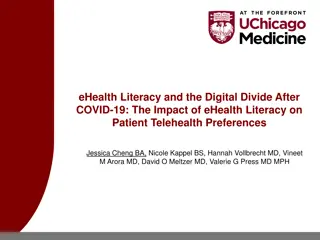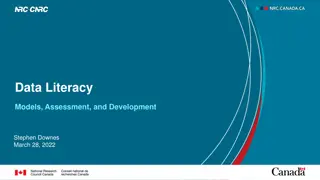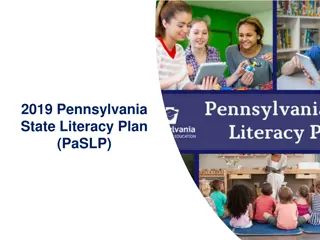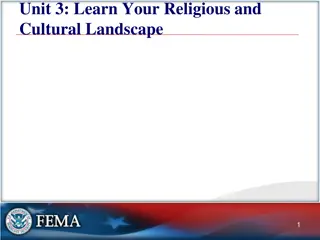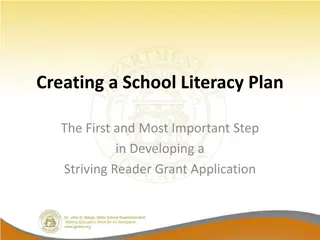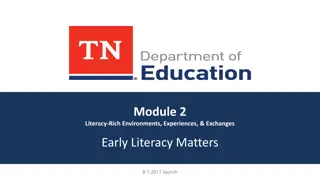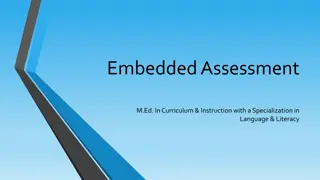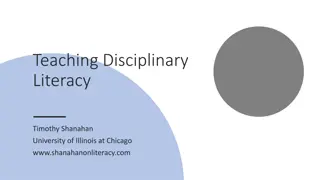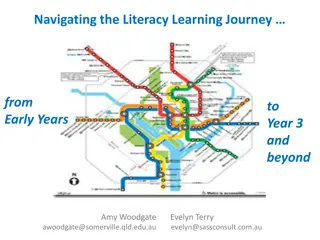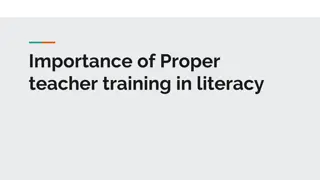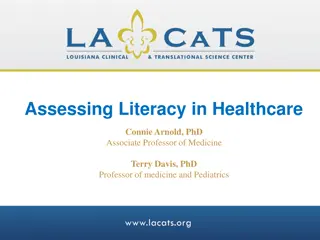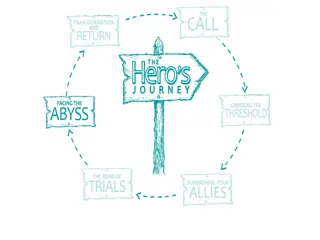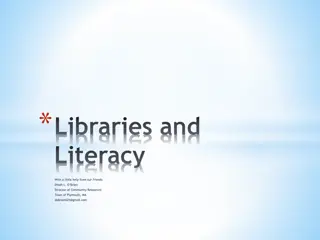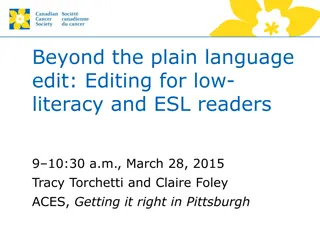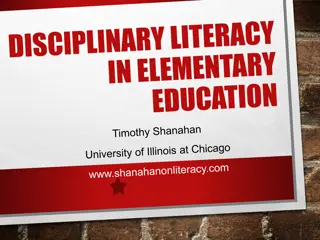Understanding Effective Literacy Assessment Strategies
Explore various assessment purposes, including formative and summative assessment, affective and cognitive assessment, and strategic content literacy assessment. Engage in activities like T-Charts, SCLAs, and scoring methods to enhance student learning outcomes and teacher strategies.
Download Presentation

Please find below an Image/Link to download the presentation.
The content on the website is provided AS IS for your information and personal use only. It may not be sold, licensed, or shared on other websites without obtaining consent from the author. Download presentation by click this link. If you encounter any issues during the download, it is possible that the publisher has removed the file from their server.
E N D
Presentation Transcript
Assessing Literacy in the Content Areas DR. JAMIE COLWELL & DR. JUDITH DUNKERLY-BEAN OLD DOMINION UNIVERSITY
Opening with Discussion Why do we assess our students? * Think-Pair-Share
Assessment Purposes Assessment FOR Learning [formative] Assessment OF Learning [summative] Assessment AS Learning Affective: Interests Attitudes Self-concept Interactive: Content Literacy Student understanding Student Self-assessment Goal setting
Assessment for Learning: Affective What s easy about [English/math/science/social studies/art, P.E./music/technology] and why? What s hard about this subject area and why? MODEL FOR STUDENTS AND SHARE Engage in a T-Chart for your most difficult content area: For me, it s MATH. What s Easy? (Reading, writing, learning) There s only one answer. Formulas are straightforward. What s Hard? (Reading, writing, learning) There s only one answer. Looks like a foreign language. Application decisions.
Assessment for Learning: Cognitive Students understandings of concepts Prompts first or next steps in planning Indicates students skill levels Provides students self-perceptions of understanding
Strategic Content Literacy Assessment (SCLA) Provides information about: How students have learned Why they didn t learn What teachers can do to help them learn SCLAs are based on clearly articulated curriculum targets and provide descriptive feedback on what and how students learn.
SCLA Activity Read the medical text you ve been provided. Circle any unfamiliar words as you read. Then answer the questions on the back of the sheet.
Scoring SCLAs Provides a whole-class snapshot of what students understand prior to beginning a lesson or unit. Let s score together by dividing into groups of 3-4.
Authentic Assessment of Learning Focus on: Vocabulary
Each content area has its own vocabulary ___________ ____________ ____________ metaphor octagon a cappella allusion decagon measure irony bisect key paradox equilateral meter symbolism quadrilateral octave simile sine tempo imagery cosine refrain Being able to speak the language means that one knows and owns it!
VOCABULARY Vocabulary is a vital part of disciplinary knowledge. In many classrooms, it is the missing piece When you teach vocabulary you teach your content!
Types of Vocabulary Receptive reading listening Expressive writing speaking Overlapping and interconnected
Overlapping but separate vocabularies facade fa ade an artificial or deceptive front
Levels of Vocabulary Comprehension Application Use Word Use of vocabulary in extended discourse Interpretive - Own Word relational knowledge Literal - Rent Word definitional knowledge Word Perception - Recognize word word configuration knowledge
Concept of Definition Map - Example What is it like? [properties or characteristics] Category: Government Structure Oppressive Tyranny Cruel COMPARISON Absolute power Democracy What are some examples? Totalitarianism Dictatorship Autocracy Remember: Graphic organizers do not have to contain words!!!
Frayer Model - Example ESSENTIAL CHARACTERISTICS Formed from dead plants and animals Formed by exposure to heat or pressure in Earth s crust over hundreds of millions of years Sometimes known as mineral fuels NON-ESSENTIAL CHARACTERISTICS Companies that mine these resources Fossil fuels Coal Oil Natural gas Water Wind Solar EXAMPLES NON-EXAMPLES
Semantic Feature Analysis SFA is a strategy for helping students see relationships among key concepts and vocabulary as well as helping teachers assess students learning both prior to and after a content lesson or unit. See handout example of a SFA for the Branches of Government.
Your Turn . . . Select a vocabulary word(s) you often teach Create a Semantic Feature Analysis for multiple terms OR Create a Concept of Definition Map or Frayer Model for one term
Vocabulary Reflection Interpretive Activity: Create a Concept Circle to represent relationships among three of your vocabulary words Application Activity: Select one word/concept and outline a RAFT that would engage students in using the word or concept
Reinforcing Vocabulary INCREASING COGNITIVE Levels of vocabulary reinforcement ENGAGEMENT Application: Use of any of the interpretive activities in writing or discourse -- Interpretive: List-Group-Label Word sorts/Categories Frayer model/Four square Analogies Graphic organizers - student generated Word Perception: Word scrambles Word finds Literal Cross word puzzles Magic square Dictionary activities Fill in the blanks
Application to Your Classroom Working with a partner, create a lesson plan for how you may use one of the following strategies discussed today: What s Easy/What s Hard SCLA Concept of Definition Map Semantic Feature Analysis Frayer Model Concept Circle





